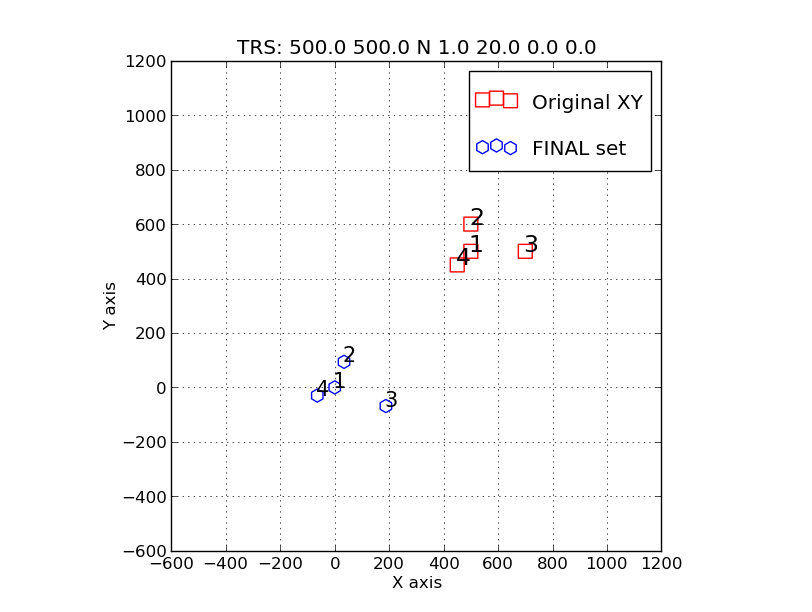A demo script for trs_apply
To run lots of trs_apply examples I built the script named Run_trs_apply.
Just like my first demo, it build the input X,Y set from a local file named
t.1. It runs trs_apply and also constructs files that make it easy to
plot various parts of the transformation sequence. Below I first show
a sample run that reproduces our first example. Then I show the run script
% ls
Run_trs_apply* TRS
% cp ../S/* .
% ls
Run_trs_apply* t.1 TRS
% cat TRS
500.0 500.0 N 1.0 20.0 0.0 0.0
% Run_trs_apply 1
# I enter the name of my data file (t.1)
A plot appears and I use it to make the figure directly below.
# # To see every step that was performed:
% cat trs_apply_ex.STEPS
Steps performed by trs_apply_ex:
Step1: trs_translate.sh file1.xy 500.0 500.0
Step2: trs_reflect.sh xy.step1_translate N
Step3: trs_scale.sh xy.step2_reflect 1.0
Step4: trs_rotate.sh xy.step3_scale 20.0
Step5: trs_translate.sh xy.step4_rotate 0.0 0.0
 |
|
An example of a trs_apply run (using Run_trs_apply) to demonstrate
a single translation (linear shift in X and Y). Here we see that the original (red squares)
Point1 at X,Y=500,500 has been translated to X,Y=0,0. Beyond this, the transformed
points (the blue hexagons) have not been altered using reflection, scale change, or rotation.
The TRS parameters used in this trs_apply run are given as the plot title.
|
****** Here is Run_trs_apply *********
#!/bin/bash
# Check command line args
if [ -z "$1" ]
then
printf "Usage:Run_trs_apply_ex 2 \n"
printf "arg1 - integer number for example number \n"
printf "Note: The trs paramters are read from ./TRS file. \n"
exit
fi
# 500.0 500.0 N 1.0 0.0 -450.0 -490.0
# Read the transformation values
if [ -e "TRS" ]
then
read XoS YoS flip scal rot XoF YoF < TRS
else
printf "\n\tError: There is no local TRS file.\n "
exit
fi
# Make the TRS file for this example
printf " $XoS $YoS $flip $scal $rot $XoF $YoF\n" > TRS.$1
# Start to build new Style file
printf "TRS: $XoS $YoS $flip $scal $rot $XoF $YoF \n" > Style.file_$1
printf "X axis\nY axis\nXY0.plot\n" >> Style.file_$1
# Build the test data set
trs_make_xy_TestData read
cp XY0.data file1.xy
# Run the transformation
trs_apply_ex file1.xy TRS.$1 Y > file2.xy
# Build the plot file to add the new set (file2.xy)
trs_build_plot_file file2.xy b h 90 15 "FINAL set" > XY2.plot
printf "XY2.plot\n" >> Style.file_$1
# Plot the set
trs_plot.py Style.file_$1 -600 1200 -600 1200 SHOW
Back to calling page
